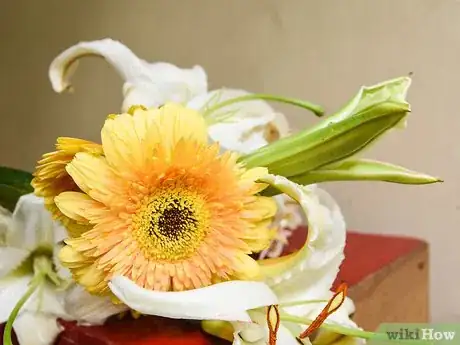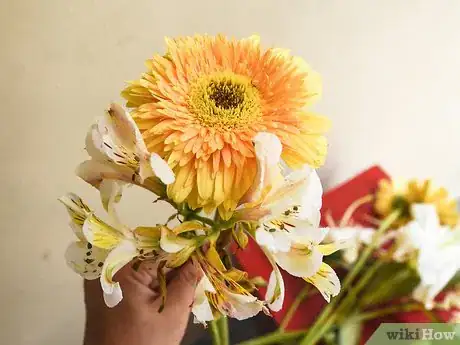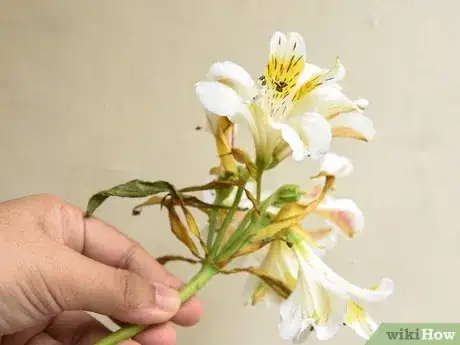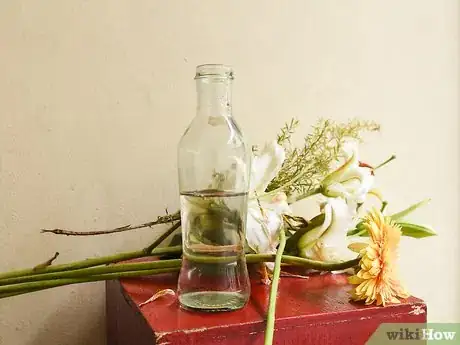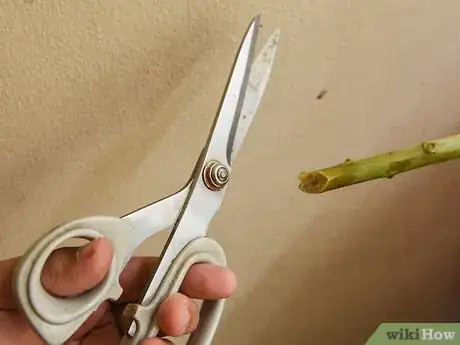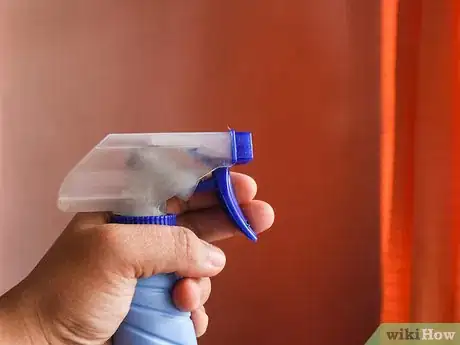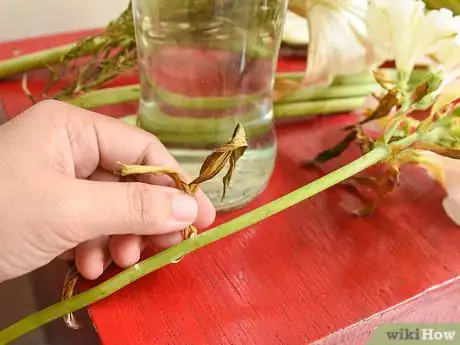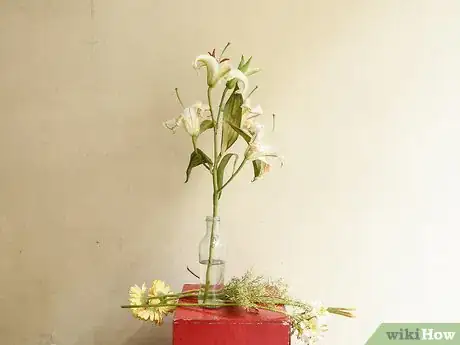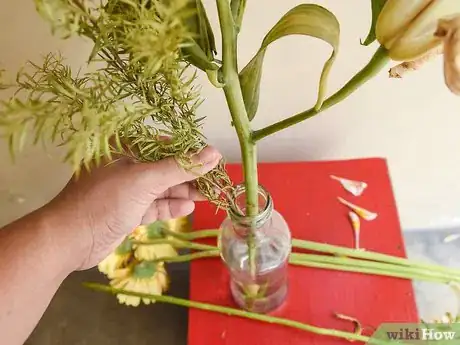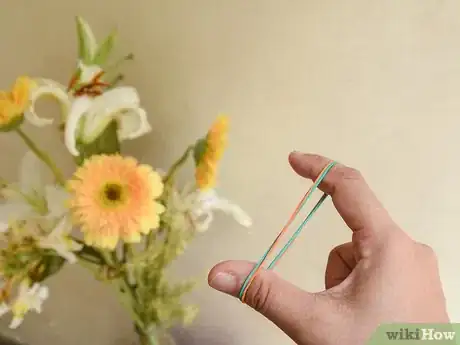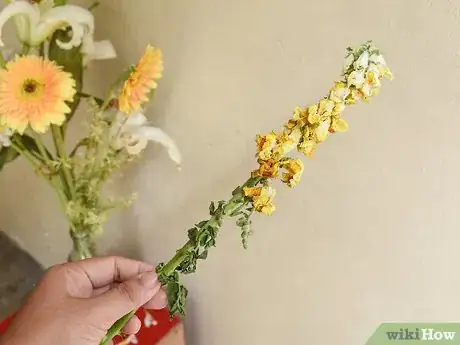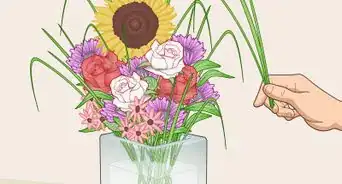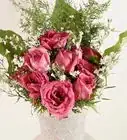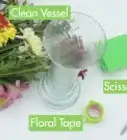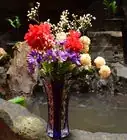This article was co-authored by Jeanne Walker. Jeanne Walker is a Florist and the Owner of Fringe Flower Company, a floral design shop that specializes in weddings, special events, and daily deliveries. Fringe Flower Company, based in Walnut Creek, California, provides customized hand-tied and vase bouquets along with potted plants, succulent gardens, tulip french buckets, and wreaths. Jeanne also conducts floral design workshops and parties throughout the San Francisco Bay Area.
There are 7 references cited in this article, which can be found at the bottom of the page.
This article has been viewed 50,846 times.
Flowers can brighten an interior space and play traditional roles in major events like weddings. Unfortunately, flowers from the florist are often grown under conditions that harm the environment and farm workers. Using cut flowers from your own garden or the garden of a cooperative friend is an inexpensive and eco-friendly alternative. With a little planning and a little know-how, you can create a lovely floral arrangement for any occasion.
Steps
Planning Your Arrangement
-
1Determine what kind of arrangement you want. This is essential before you do anything else. For a hand-held bouquet, you will need to know the best possible date to prepare the arrangement so that the flowers are still fresh for the big occasion. For a centerpiece or hanging basket, you will need to figure out how much space needs to be cleared so that the arrangement will fit.
-
2Pick your color scheme. You could either select flowers for your bouquet in a range of colors or go with a monochromatic (based on one color) scheme. You should determine which flowers will not clash with the colors in the room you choose for your arrangement or with the attire of the person holding the bouquet.
- If you are arranging a bridal bouquet for someone who wants to wear a green dress, red flowers (which is the complementary—opposite—color of green) might create an overly intense effect.
Advertisement -
3Choose flowers that will fit the color scheme. Whether you choose a monochromatic or multicolored scheme, you can go with one species or a variety of them. For a multicolored scheme, you have more options, but you should avoid colors that clash with one another.
- For a monochromatic scheme based on red, you could go completely with red roses or mix it up with pink and light purple flowers.
- Sunflowers and violets might clash with each other if you don’t add colors that will offset the yellow and deep purple.
-
4Select your container. Choose a vase or flowerpot that will hold all of the flowers without a great deal of open or leftover space. Make sure the container is small enough to avoid dwarfing the arrangement yet large enough to withstand the added weight of larger stems or blooms. The blooms should be able to fit tightly against one another when arranged.
-
5Obtain your flowers. This is rather easy if you or a friendly neighbor has a flower garden. If this is not the case, you will need to find a florist that will allow you to buy unarranged flowers. Make sure the flowers are newly cut so that they will last as long as possible. Flowers that haven’t bloomed yet are also a good choice.
- Although organic flowers are more expensive, they are a safer choice. Even if you are not designing a hand-held bouquet or plan to wear gloves as you arrange the flowers, chemicals can become airborne.
Preparing the Flowers
-
1Determine the height of the bouquet. The size of the vase or where the bouquet will be displayed will often determine the overall height of the arrangement. Consider how long or short the stems should be. Sometimes, flowers with overhanging parts will be necessary.
- For smaller vases and spaces, shorten the stems of the flowers.
- Opt for longer stems and trailing blossoms, such as roses or fuchsias, for larger vases and open areas.
- Go with flowers with long overhanging leaves or vines, such as impatiens or zinnias, for hanging baskets.[1]
-
2Trim off the ends of the stems. Use clean gardening shears or clippers. Start by removing the material on the lower inch (2.54cm) of the main stem. Gradually remove enough stem so that the flowers fit your vase neatly. Snip at a 45-degree angle to allow for efficient water absorption.[2]
-
3Treat the blossoms. Because cut flowers are no longer have roots to connect them to the soil, they will eventually wilt. Although many flower preservation hacks have been debunked (see Warnings), some can maintain the freshness of cut flowers. All you need are a few common household items.
- Wrap the ends of roses in brown paper, and dip them in boiling water to force air from the stems. Leave them in the water until it cools, then trim the stems again.[3]
- Spray cooking spray on tropical flowers to help seal in their moisture.[4]
- Dip the heads of hydrangeas and other large flowers into water. Soak them for a few minutes before arranging them.[5]
-
4Remove foliage below the water level. Fill ¾ of the vase with water. Before creating the final arrangement, dip each flower in the water. Take note of any leaves below the water level, and remove them. This will slow the growth of bacteria that could speed up the demise of the flowers and create a foul odor.[6]
Creating the Arrangement
-
1Create a focal point. Place the larger, more vivid blossoms in the vase first. Then, place the smaller blooms or buds around them. This will give the arrangement a sense of stability. It will also first draw the viewer’s eyes to the center of the arrangement.
- In a peony arrangement, place a larger red flower in the center. Surround it with pink and white blossoms either in full bloom or in a budding stage.
-
2Create balance. Add some support to the bouquet so that it doesn’t lean to one side. Use tree branches or twigs adjusted to the size of the arrangement to hold up more delicate flowers. Make sure smaller or flowers or buds are interspersed throughout the larger ones to prevent a sense of lopsidedness.
- For example, intersperse pink tulips, white peonies, irises, and pink delphiniums so that each color is evenly distributed throughout the arrangement.
-
3Create variety. Vary the blossoms in height and color evenly throughout the arrangement. Tuck smaller flowers or buds around the edges. Keep taller plants toward the center and top.
- For example, arrange aster, blue veronica, blue lisianthus, and larkspur as the base colors. Add accents to the color scheme with red dahlias and “Black Prince” snapdragons inserted between the lighter hues.
- Think about the size of the flowers you want to showcase. For instance, if you're making a bouquet with roses, you might add smaller flowers to the arrangement so the roses will be the star of the show.[7]
-
4Rotate the vase. Do this constantly as you place the flowers inside it. Rotation will ensure you don't neglect any one area and give an even hand to the entire bouquet.
-
5Tie it all together. When you’re satisfied with the appearance of the bouquet, tie the stems together right at the waterline. This will pack the flowers tightly together and force them to support one another.
- Use a clear elastic band to avoid detracting attention from the flowers.
- Use twine for a more rustic appearance.
- Use ribbon to add a decorative touch to a bridal bouquet.
-
6Reuse dead flowers. Like all organic material, dead flowers emit methane (a greenhouse gas 24 times as powerful as CO2) when taken to the landfill. Get crafty by reusing your flowers as they begin to wilt and die. Use your new creations as home décor or as unique gifts.
- If you have a compost heap or a municipal composting program, you can reuse your flowers by turning them into organic fertilizer. Just make sure your flowers were not treated with chemicals or grown with genetically modified seeds beforehand.
Community Q&A
-
QuestionHow do I make a bouquet to carry?
 Community AnswerArrange the bouquet, but make sure that all the stalks are more or less the same length. Then, put them into a vase of water. When you need to carry them without the vase, simply lift the flowers out, line up the stalks and tie up with an elastic. You can cover the elastic with a ribbon.
Community AnswerArrange the bouquet, but make sure that all the stalks are more or less the same length. Then, put them into a vase of water. When you need to carry them without the vase, simply lift the flowers out, line up the stalks and tie up with an elastic. You can cover the elastic with a ribbon.
Warnings
- Don’t cut the flower stems with common household scissors, which are designed for thin items like paper and fabric. Scissors will crush floral vascular systems, causing them to die much more quickly.[8]⧼thumbs_response⧽
- Don’t add aspirins, pennies, mouthwash or bleach to the water. These “hacks” do not work and can actually harm the flowers.[9]⧼thumbs_response⧽
Things You'll Need
- Vase
- Water
- Brown paper
- Cooking spray
- Garden shears or clippers
References
- ↑ http://www.motherearthliving.com/your-natural-home/how-to-arrange-flowers-zinnia-bouquet
- ↑ http://www.bbg.org/gardening/article/cut-flower_care
- ↑ http://www.countryliving.com/entertaining/g835/arrange-flowers-0809/?slide=4
- ↑ http://www.countryliving.com/entertaining/g835/arrange-flowers-0809/?slide=5
- ↑ http://www.countryliving.com/entertaining/g835/arrange-flowers-0809/?slide=9
- ↑ http://www.bbg.org/gardening/article/cut-flower_care
- ↑ Jeanne Walker. Florist. Expert Interview. 15 April 2020.
- ↑ http://www.bbg.org/gardening/article/cut-flower_care
- ↑ http://www.realsimple.com/home-organizing/gardening/gardening-flowers/keep-cut-flowers-fresh
About This Article
To arrange a bouquet of flowers, first decide whether you want a hand-held bouquet, a centerpiece, or a hanging basket so you’ll know how many flowers you need. When you’re choosing flowers, consider the height and color scheme of your arrangement, and trim the flower stems if necessary. As you arrange the flowers, create a focal point from the largest, most vivid blossoms. Then, place smaller blooms or buds around them. Use tree branches or twigs as supports, and mix in greenery if you like. For tips on preparing your flowers, like how to cut the stems, keep reading!
